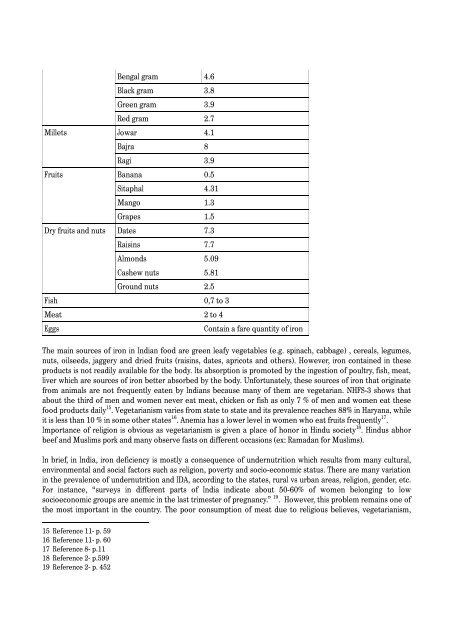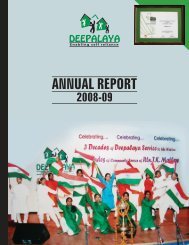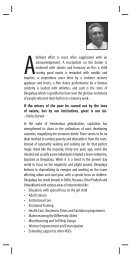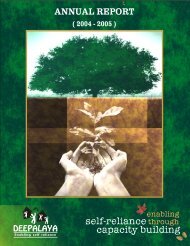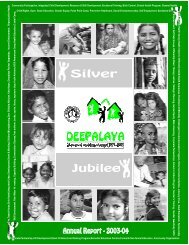Report 2011 - Deepalaya
Report 2011 - Deepalaya
Report 2011 - Deepalaya
You also want an ePaper? Increase the reach of your titles
YUMPU automatically turns print PDFs into web optimized ePapers that Google loves.
Millets<br />
Fruits<br />
Dry fruits and nuts<br />
Bengal gram 4.6<br />
Black gram 3.8<br />
Green gram 3.9<br />
Red gram 2.7<br />
Jowar 4.1<br />
Bajra 8<br />
Ragi 3.9<br />
Banana 0.5<br />
Sitaphal 4.31<br />
Mango 1.3<br />
Grapes 1.5<br />
Dates 7.3<br />
Raisins 7.7<br />
Almonds 5.09<br />
Cashew nuts 5.81<br />
Ground nuts 2.5<br />
Fish 0,7 to 3<br />
Meat 2 to 4<br />
Eggs<br />
Contain a fare quantity of iron<br />
The main sources of iron in Indian food are green leafy vegetables (e.g. spinach, cabbage) , cereals, legumes,<br />
nuts, oilseeds, jaggery and dried fruits (raisins, dates, apricots and others). However, iron contained in these<br />
products is not readily available for the body. Its absorption is promoted by the ingestion of poultry, fish, meat,<br />
liver which are sources of iron better absorbed by the body. Unfortunately, these sources of iron that originate<br />
from animals are not frequently eaten by Indians because many of them are vegetarian. NHFS-3 shows that<br />
about the third of men and women never eat meat, chicken or fish as only 7 % of men and women eat these<br />
food products daily 15 . Vegetarianism varies from state to state and its prevalence reaches 88% in Haryana, while<br />
it is less than 10 % in some other states 16 . Anemia has a lower level in women who eat fruits frequently 17 .<br />
Importance of religion is obvious as vegetarianism is given a place of honor in Hindu society 18 . Hindus abhor<br />
beef and Muslims pork and many observe fasts on different occasions (ex: Ramadan for Muslims).<br />
In brief, in India, iron deficiency is mostly a consequence of undernutrition which results from many cultural,<br />
environmental and social factors such as religion, poverty and socio-economic status. There are many variation<br />
in the prevalence of undernutrition and IDA, according to the states, rural vs urban areas, religion, gender, etc.<br />
For instance, “surveys in different parts of India indicate about 50-60% of women belonging to low<br />
socioeconomic groups are anemic in the last trimester of pregnancy.” 19 . However, this problem remains one of<br />
the most important in the country. The poor consumption of meat due to religious believes, vegetarianism,<br />
15 Reference 11- p. 59<br />
16 Reference 11- p. 60<br />
17 Reference 8- p.11<br />
18 Reference 2- p.599<br />
19 Reference 2- p. 452


